Near Field Models of Spatially-Fed Planar Arrays and Their Application to Multi-Frequency Direct Layout Optimization for mm-Wave 5G New Radio Indoor Network Coverage
Abstract
:1. Introduction
2. Statement of the Problem
3. Near Field Models of Reflectarray and Transmitarray Antennas
3.1. Field at the Aperture
3.2. Near Field from the Radiation Equations
3.3. Near Field as Superposition of Far Field Contributions
3.4. Change of Coordinates
3.5. Comparison of the Near Field Models
4. Wideband near Field Shaping with Application to Indoor Femtocell Coverage
4.1. Scenario Definition and Antenna Specifications
4.2. Unit Cell Characterization
4.3. Phase-Only Synthesis at 28 GHz
4.4. Multi-Frequency Optimization of the Near Field
4.5. Discussion
5. Conclusions
Funding
Institutional Review Board Statement
Informed Consent Statement
Data Availability Statement
Acknowledgments
Conflicts of Interest
Abbreviations
| 5G NR | Fifth generation new radio |
| ACS | Array coordinate system |
| DLO | Direct layout optimization |
| DoF | Degrees of freedom |
| FF | Far field |
| FFT | Fast Fourier transform |
| FR | Frequency Range |
| GIA | Generalized intersection approach |
| MoM-LP | Method of moments based on local periodicity |
| NF | Near field |
| NFCS | Near field coordinate system |
| POS | Phase-only synthesis |
Appendix A

References
- Ly, A.; Yao, Y.D. A Review of Deep Learning in 5G Research: Channel Coding, Massive MIMO, Multiple Access, Resource Allocation, and Network Security. IEEE Open J. Commun. Soc. 2021, 2, 396–408. [Google Scholar] [CrossRef]
- Boccardi, F.; Heath, R.W.; Lozano, A.; Marzetta, T.L.; Popovski, P. Five disruptive technology directions for 5G. IEEE Commun. Mag. 2014, 52, 74–80. [Google Scholar] [CrossRef] [Green Version]
- Attaran, M. The impact of 5G on the evolution of intelligent automation and industry digitization. J. Ambient Intell. Humaniz. Comput. 2021. [Google Scholar] [CrossRef]
- Gohar, A.; Nencioni, G. The Role of 5G Technologies in a Smart City: The Case for Intelligent Transportation System. Sustainability 2021, 13, 5188. [Google Scholar] [CrossRef]
- Wijethilaka, S.; Liyanage, M. Survey on Network Slicing for Internet of Things Realization in 5G Networks. IEEE Commun. Surv. Tutor. 2021, 23, 957–994. [Google Scholar] [CrossRef]
- Arrubla-Hoyos, W.; Ojeda-Beltrán, A.; Solano-Barliza, A.; Rambauth-Ibarra, G.; Barrios-Ulloa, A.; Cama-Pinto, D.; Arrabal-Campos, F.M.; Martínez-Lao, J.A.; Cama-Pinto, A.; Manzano-Agugliaro, F. Precision Agriculture and Sensor Systems Applications in Colombia through 5G Networks. Sensors 2022, 22, 7295. [Google Scholar] [CrossRef]
- Szalay, Z.; Ficzere, D.; Tihanyi, V.; Magyar, F.; Soós, G.; Varga, P. 5G-Enabled Autonomous Driving Demonstration with a V2X Scenario-in-the-Loop Approach. Sensors 2020, 20, 7344. [Google Scholar] [CrossRef]
- Rischke, J.; Sossalla, P.; Itting, S.; Fitzek, F.H.P.; Reisslein, M. 5G Campus Networks: A First Measurement Study. IEEE Access 2021, 9, 121786–121803. [Google Scholar] [CrossRef]
- Hong, W.; Jiang, Z.H.; Yu, C.; Hou, D.; Wang, H.; Guo, C.; Hu, Y.; Kuai, L.; Yu, Y.; Jiang, Z.; et al. The Role of Millimeter-Wave Technologies in 5G/6G Wireless Communications. IEEE J. Microw. 2021, 1, 101–122. [Google Scholar] [CrossRef]
- 3GPP. Technical Specification Group Radio Access Network; NR; User Equipment (UE) Radio Transmission and Reception; Part 2: Range 2 Standalone (Release 17); Technical Report; 3GPP: Sophia Antipolis, France, 2022; Available online: https://www.3gpp.org/ftp/Specs/archive/38_series/38.101-2/ (accessed on 6 October 2022).
- Zheng, K.; Wang, D.; Han, Y.; Zhao, X.; Wang, D. Performance and Measurement Analysis of a Commercial 5G Millimeter-Wave Network. IEEE Access 2020, 8, 163996–164011. [Google Scholar] [CrossRef]
- Poularakis, K.; Iosifidis, G.; Sourlas, V.; Tassiulas, L. Exploiting Caching and Multicast for 5G Wireless Networks. IEEE Trans. Wirel. Commun. 2016, 15, 2995–3007. [Google Scholar] [CrossRef]
- Soleimani, B.; Sabbaghian, M. Cluster-Based Resource Allocation and User Association in mmWave Femtocell Networks. IEEE Trans. Commun. 2020, 68, 1746–1759. [Google Scholar] [CrossRef]
- Nemati, M.; Park, J.; Choi, J. RIS-Assisted Coverage Enhancement in Millimeter-Wave Cellular Networks. IEEE Access 2020, 8, 188171–188185. [Google Scholar] [CrossRef]
- Okogbaa, F.C.; Ahmed, Q.Z.; Khan, F.A.; Abbas, W.B.; Che, F.; Zaidi, S.A.R.; Alade, T. Design and Application of Intelligent Reflecting Surface (IRS) for Beyond 5G Wireless Networks: A Review. Sensors 2022, 22, 2436. [Google Scholar] [CrossRef]
- Pérez-Adán, D.; Fresnedo, O.; González-Coma, J.P.; Castedo, L. Intelligent Reflective Surfaces for Wireless Networks: An Overview of Applications, Approached Issues, and Open Problems. Electronics 2021, 10, 2345. [Google Scholar] [CrossRef]
- Imaz-Lueje, B.; Vaquero, A.F.; Prado, D.R.; Pino, M.R.; Arrebola, M. Shaped-Pattern Reflectarray Antennas for mm-Wave Networks Using a Simple Cell Topology. IEEE Access 2022, 10, 12580–12591. [Google Scholar] [CrossRef]
- Martinez-De-Rioja, D.; Encinar, J.A.; Martinez-De-Rioja, E.; Vaquero, A.F.; Arrebola, M. A Simple Beamforming Technique for Intelligent Reflecting Surfaces in 5G Scenarios. In Proceedings of the International Workshop on Antenna Technology (iWAT), Dublin, Ireland, 16–18 May 2022; pp. 249–252. [Google Scholar] [CrossRef]
- Loredo, S.; León, G.; Plaza, E.G. A Fast Approach to Near-Field Synthesis of Transmitarrays. IEEE Antennas Wirel. Propag. Lett. 2021, 20, 648–652. [Google Scholar] [CrossRef]
- Vaquero, A.F.; Pino, M.R.; Arrebola, M. Evaluation of a transmit-array base station for mm-wave communications in the Fresnel region. In Proceedings of the IEEE International Symposium on Antennas and Propagation (AP-S), Denver, CO, USA, 10–15 July 2022; pp. 788–789. [Google Scholar] [CrossRef]
- Prado, D.R. The Generalized Intersection Approach for Electromagnetic Array Antenna Beam-Shaping Synthesis: A Review. IEEE Access 2022, 10, 87053–87068. [Google Scholar] [CrossRef]
- Loredo, S.; Plaza, E.G.; León, G. Fast Transmitarray Synthesis with Far-Field and Near-Field Constraints. Sensors 2022, 22, 4355. [Google Scholar] [CrossRef]
- Prado, D.R.; López-Fernández, J.A.; Arrebola, M.; Pino, M.R.; Goussetis, G. General Framework for the Efficient Optimization of Reflectarray Antennas for Contoured Beam Space Applications. IEEE Access 2018, 6, 72295–72310. [Google Scholar] [CrossRef]
- Vaquero, A.F.; Arrebola, M.; Pino, M.R. Bandwidth response of a reflectarray antenna working as a Compact Antenna Test Range probe. In Proceedings of the AMTA 41st Annual Meeting & Symposium, San Diego, CO, USA, 6–11 October 2019; pp. 1–6. Available online: http://hdl.handle.net/10651/54227 (accessed on 9 September 2022).
- Balanis, C.A. Advanced Engineering Electromagnetics, 2nd ed.; John Wiley & Sons: Hoboken, NJ, USA, 2012. [Google Scholar]
- Stutzman, W.L.; Thiele, G.A. Antenna Theory and Design, 3rd ed.; John Wiley & Sons: Hoboken, NJ, USA, 2012. [Google Scholar]
- Mittra, R.; Chan, C.H.; Cwik, T. Techniques for analyzing frequency selective surfaces—A review. Proc. IEEE 1988, 76, 1593–1615. [Google Scholar] [CrossRef]
- Prado, D.R.; Arrebola, M.; Pino, M.R.; Las-Heras, F. An efficient calculation of the far field radiated by non-uniformly sampled planar fields complying Nyquist theorem. IEEE Trans. Antennas Propag. 2015, 63, 862–865. [Google Scholar] [CrossRef]
- Lo, Y.T.; Lee, S.W. (Eds.) Antenna Handbook; Van Nostrand Reinhold: New York, NY, USA, 1993; Volume 1, Chapter 1; pp. 28–29. [Google Scholar]
- Sato, M. OpenMP: Parallel programming API for shared memory multiprocessors and on-chip multiprocessors. In Proceedings of the 15th International Symposium on System Synthesis, Kyoto, Japan, 2–4 October 2002; pp. 109–111. [Google Scholar] [CrossRef]
- MagicDesk. Office Sitting Room Executive Business Desk. Available online: https://pixabay.com/photos/office-sitting-room-executive-730681/ (accessed on 9 September 2022).
- Huang, J.; Encinar, J.A. Reflectarray Antennas; John Wiley & Sons: Hoboken, NJ, USA, 2008. [Google Scholar]
- Prado, D.R.; Arrebola, M.; Pino, M.R.; Las-Heras, F. Improved Reflectarray Phase-Only Synthesis Using the Generalized Intersection Approach with Dielectric Frame and First Principle of Equivalence. Int. J. Antennas Propag. 2017, 2017, 3829390. [Google Scholar] [CrossRef] [Green Version]
- Nepa, P.; Buffi, A. Near-Field-Focused Microwave Antennas: Near-field shaping and implementation. IEEE Antennas Propag. Mag. 2017, 59, 42–53. [Google Scholar] [CrossRef]
- Wan, C.; Encinar, J.A. Efficient computation of generalized scattering matrix for analyzing multilayered periodic structures. IEEE Trans. Antennas Propag. 1995, 43, 1233–1242. [Google Scholar] [CrossRef]
- Prado, D.R.; Arrebola, M.; Pino, M.R.; Goussetis, G. Broadband Reflectarray with High Polarization Purity for 4K and 8K UHDTV DVB-S2. IEEE Access 2020, 8, 100712–100720. [Google Scholar] [CrossRef]
- Prado, D.R.; Vaquero, A.F.; Arrebola, M.; Pino, M.R.; Las-Heras, F. Acceleration of Gradient-Based Algorithms for Array Antenna Synthesis with Far Field or Near Field Constraints. IEEE Trans. Antennas Propag. 2018, 66, 5239–5248. [Google Scholar] [CrossRef]
- Encinar, J.A.; Zornoza, J.A. Three-layer printed reflectarrays for contoured beam space applications. IEEE Trans. Antennas Propag. 2004, 52, 1138–1148. [Google Scholar] [CrossRef]
- Prado, D.R.; López-Fernández, J.A.; Arrebola, M. Efficient General Reflectarray Design and Direct Layout Optimization with a Simple and Accurate Database Using Multilinear Interpolation. Electronics 2022, 11, 191. [Google Scholar] [CrossRef]
- Prado, D.R.; López-Fernández, J.A.; Arrebola, M.; Goussetis, G. Support Vector Regression to Accelerate Design and Crosspolar Optimization of Shaped-Beam Reflectarray Antennas for Space Applications. IEEE Trans. Antennas Propag. 2019, 67, 1659–1668. [Google Scholar] [CrossRef]
- Pontoppidan, K. GRASP9 Technical Description; TICRA: Copenhagen, Denmark, 2008. [Google Scholar]



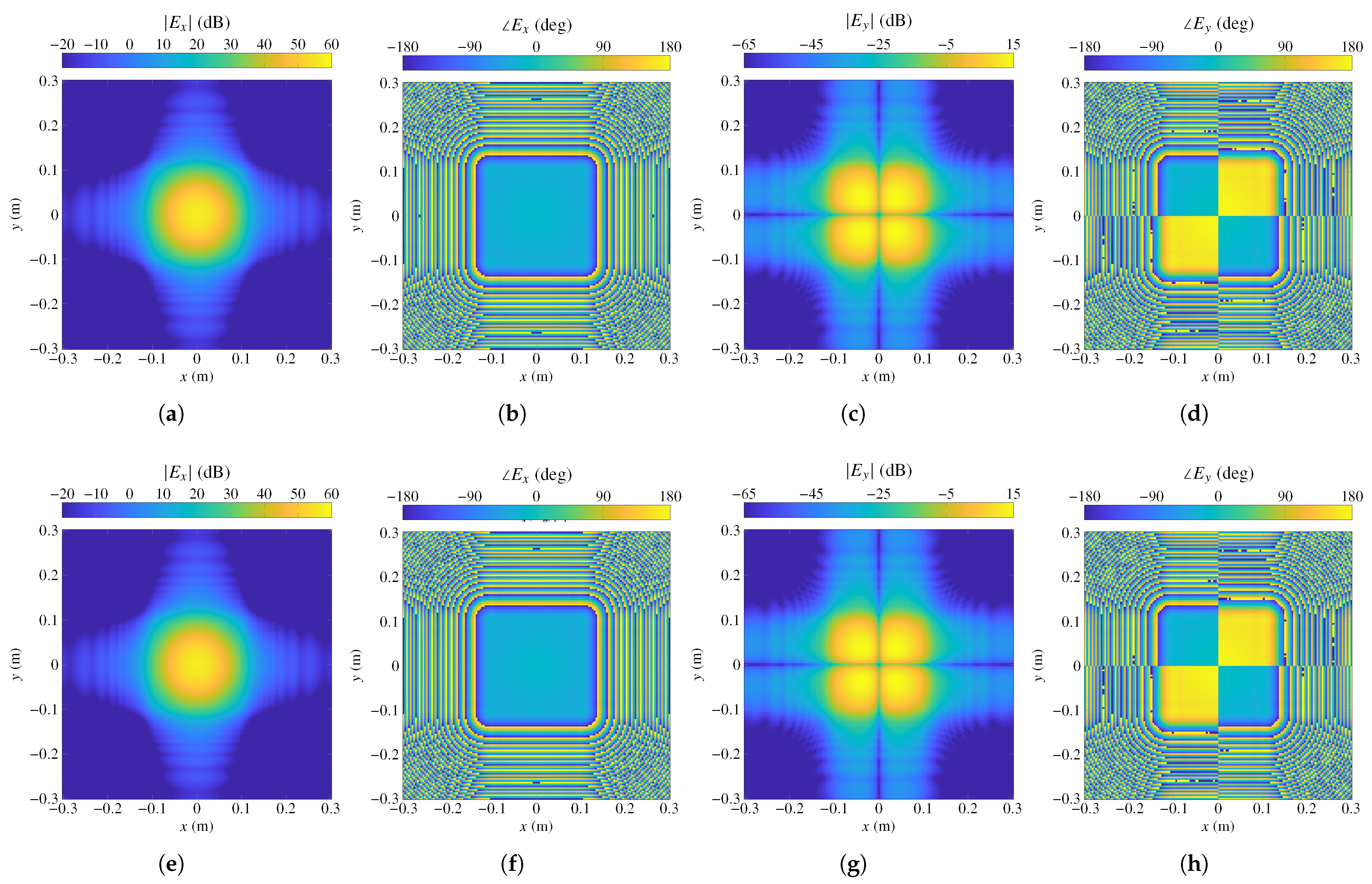
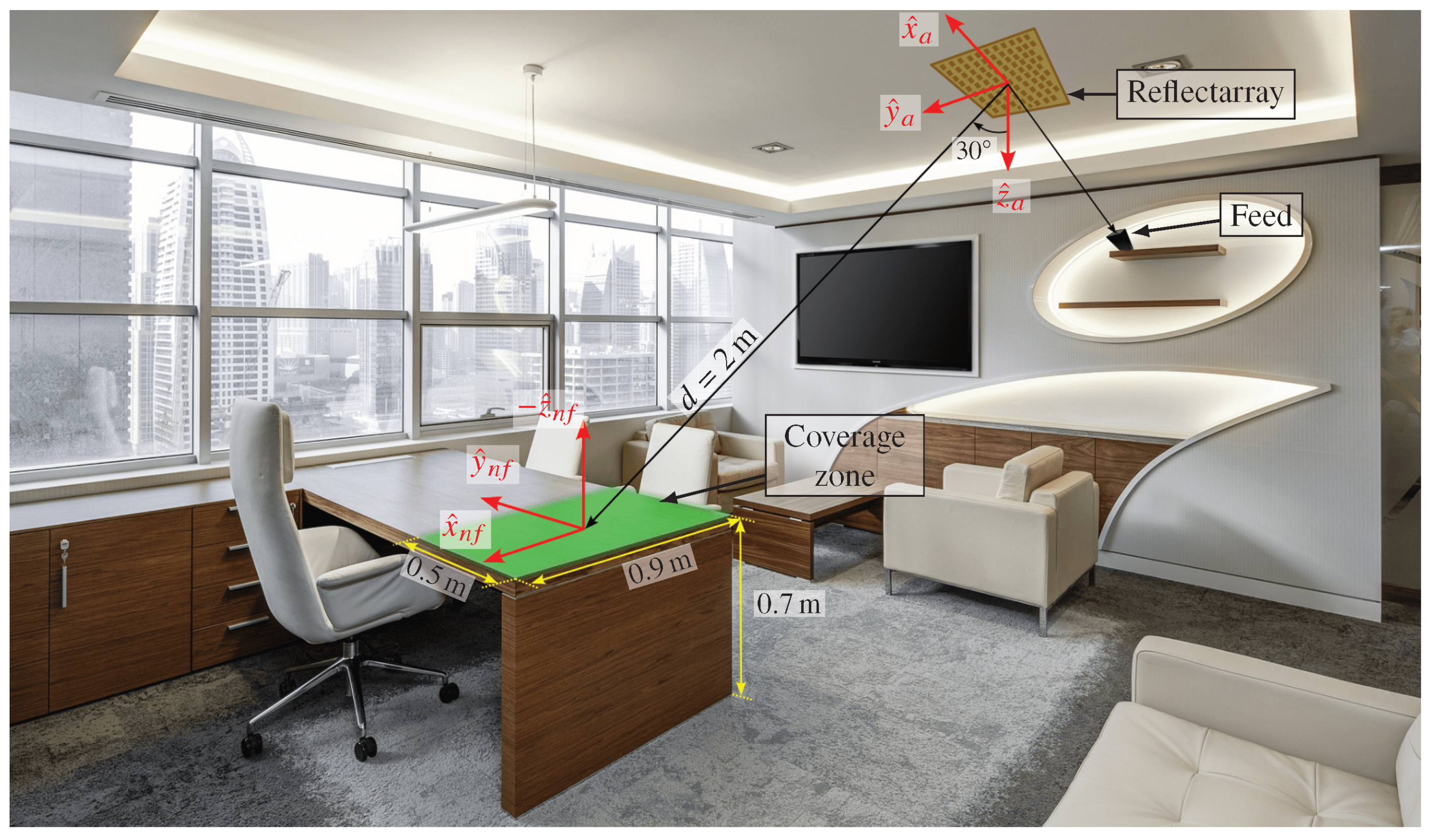

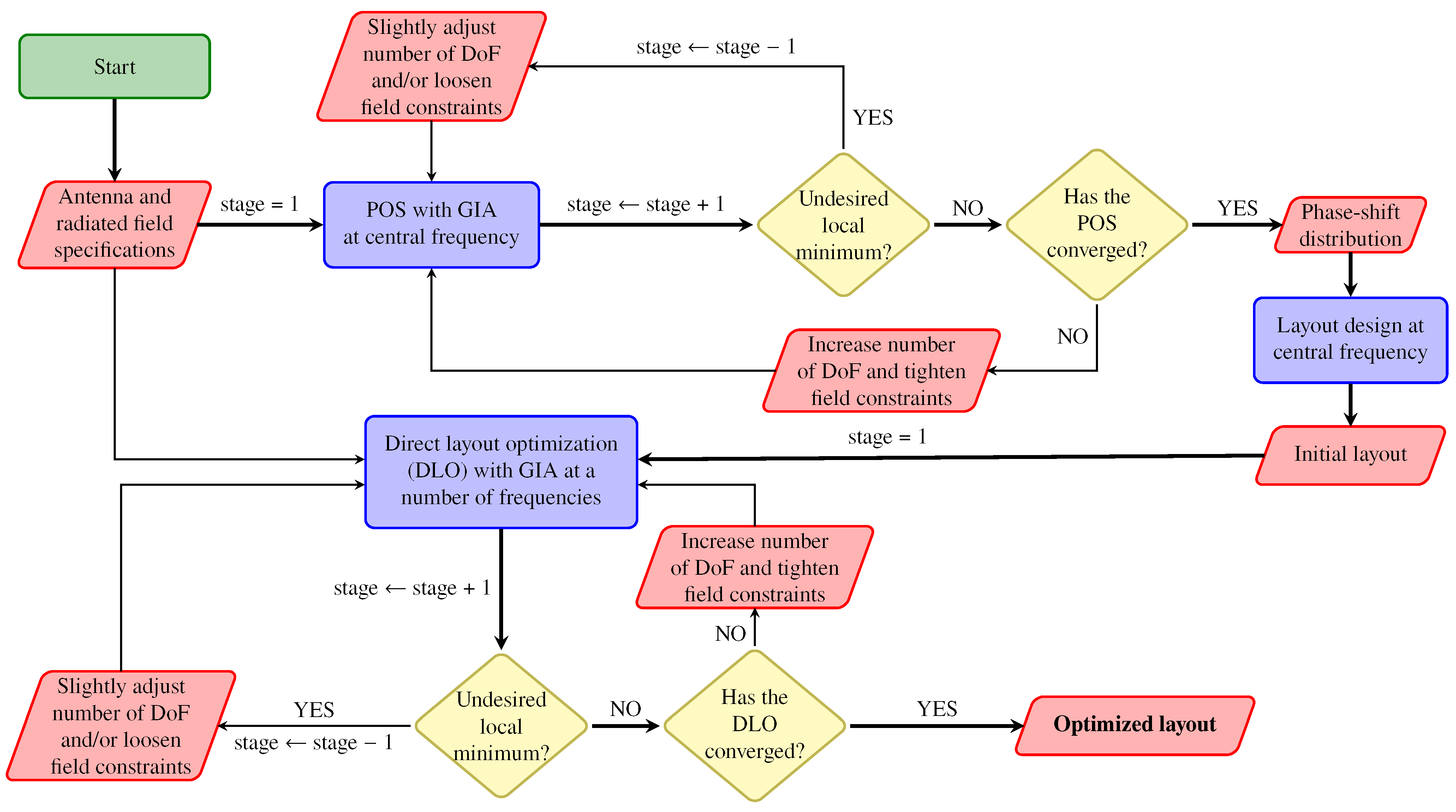
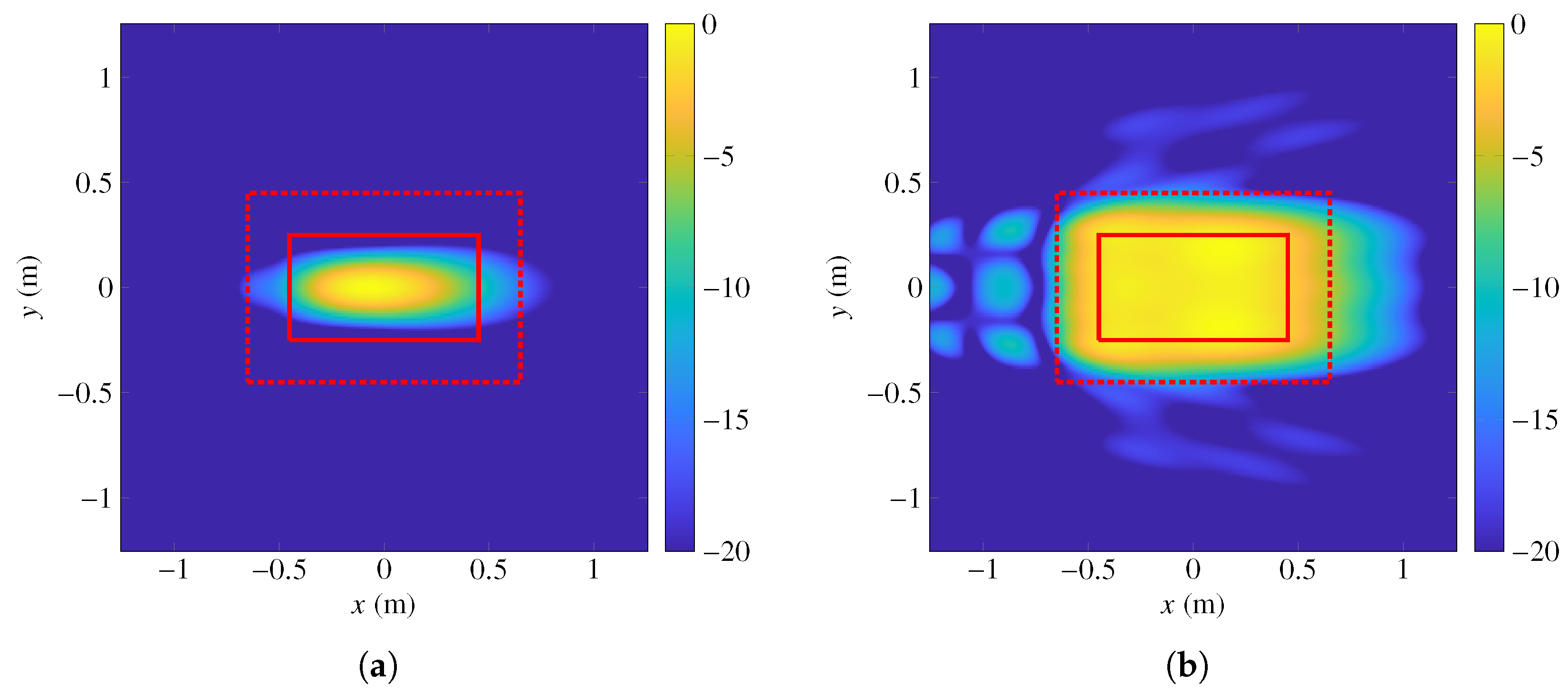
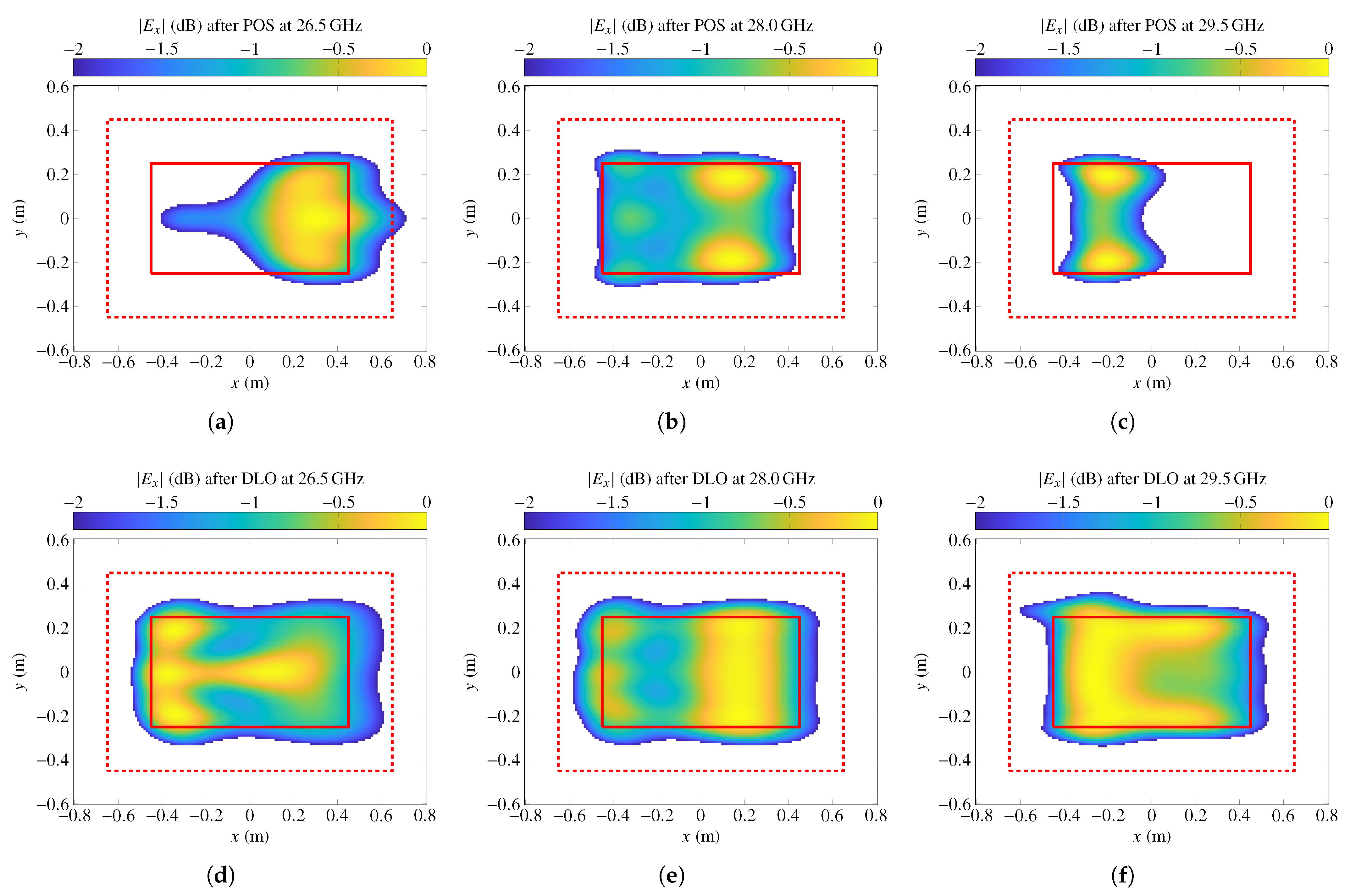
| FF contributions | 2.22% | 2.21% | 3.20% | 0.22% | 0.22% | 0.32% |
| NF () | 0.09% | 0.33% | 3.10% | 0.06% | 0.14% | 0.15% |
| NF () | 0.01% | 0.02% | 0.18% | 0.00% | 0.01% | 0.01% |
| Model | Time (s) |
|---|---|
| FF contributions | 1.40 |
| NF () | 24.65 |
| NF () | 168.45 |
| NF () | 455.89 |
| Frequency (GHz) | Polarization X | Polarization Y | ||||||
|---|---|---|---|---|---|---|---|---|
| Ripple (dB) | 1 dB (%) | 2 dB (%) | 3 dB (%) | Ripple (dB) | 1 dB (%) | 2 dB (%) | 3 dB (%) | |
| 26.5 | 5.34 | 42.45 | 63.35 | 82.03 | 5.92 | 30.40 | 58.80 | 78.97 |
| 27.0 | 3.79 | 47.17 | 71.23 | 98.79 | 3.97 | 43.83 | 73.20 | 98.45 |
| 27.5 | 2.53 | 43.63 | 93.75 | 100 | 2.53 | 48.57 | 89.96 | 100 |
| 28.0 | 2.66 | 51.28 | 96.44 | 100 | 2.48 | 45.14 | 99.10 | 100 |
| 28.5 | 3.74 | 58.82 | 86.04 | 96.40 | 3.58 | 52.70 | 90.61 | 98.49 |
| 29.0 | 6.39 | 33.76 | 54.02 | 81.71 | 5.03 | 54.69 | 81.71 | 89.96 |
| 29.5 | 9.19 | 26.42 | 44.32 | 57.55 | 7.37 | 37.15 | 63.18 | 77.81 |
| Frequency (GHz) | Polarization X | Polarization Y | ||||||
|---|---|---|---|---|---|---|---|---|
| Ripple (dB) | 1 dB (%) | 2 dB (%) | 3 dB (%) | Ripple (dB) | 1 dB (%) | 2 dB (%) | 3 dB (%) | |
| 26.5 | 1.30 | 80.89 | 100 | 100 | 0.82 | 100 | 100 | 100 |
| 27.0 | 1.03 | 99.63 | 100 | 100 | 0.84 | 100 | 100 | 100 |
| 27.5 | 1.08 | 95.63 | 100 | 100 | 0.96 | 100 | 100 | 100 |
| 28.0 | 1.23 | 84.90 | 100 | 100 | 0.96 | 100 | 100 | 100 |
| 28.5 | 1.26 | 76.73 | 100 | 100 | 1.02 | 99.07 | 100 | 100 |
| 29.0 | 1.25 | 96.72 | 100 | 100 | 1.16 | 93.67 | 100 | 100 |
| 29.5 | 1.50 | 89.05 | 100 | 100 | 1.49 | 90.52 | 100 | 100 |
Publisher’s Note: MDPI stays neutral with regard to jurisdictional claims in published maps and institutional affiliations. |
© 2022 by the author. Licensee MDPI, Basel, Switzerland. This article is an open access article distributed under the terms and conditions of the Creative Commons Attribution (CC BY) license (https://creativecommons.org/licenses/by/4.0/).
Share and Cite
Prado, D.R. Near Field Models of Spatially-Fed Planar Arrays and Their Application to Multi-Frequency Direct Layout Optimization for mm-Wave 5G New Radio Indoor Network Coverage. Sensors 2022, 22, 8925. https://doi.org/10.3390/s22228925
Prado DR. Near Field Models of Spatially-Fed Planar Arrays and Their Application to Multi-Frequency Direct Layout Optimization for mm-Wave 5G New Radio Indoor Network Coverage. Sensors. 2022; 22(22):8925. https://doi.org/10.3390/s22228925
Chicago/Turabian StylePrado, Daniel R. 2022. "Near Field Models of Spatially-Fed Planar Arrays and Their Application to Multi-Frequency Direct Layout Optimization for mm-Wave 5G New Radio Indoor Network Coverage" Sensors 22, no. 22: 8925. https://doi.org/10.3390/s22228925
APA StylePrado, D. R. (2022). Near Field Models of Spatially-Fed Planar Arrays and Their Application to Multi-Frequency Direct Layout Optimization for mm-Wave 5G New Radio Indoor Network Coverage. Sensors, 22(22), 8925. https://doi.org/10.3390/s22228925






